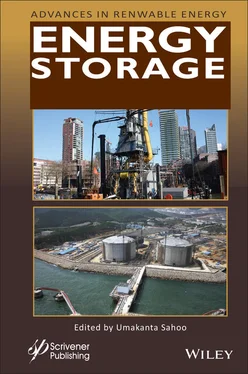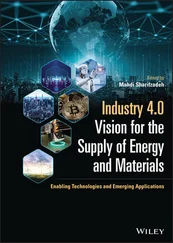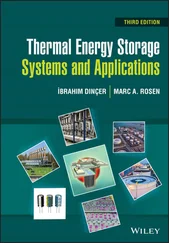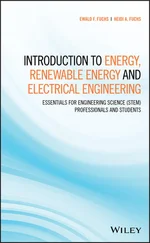1.2.1.3 Central Receiver Plants
A circular array of large mirrors with sun-tracking motion (called heliostats) reflect direct sunlight onto an absorber system in central receiver. Such systems are also called power tower as the receiver is mounted on the top of a tower [ Figure 1.3]. This is a point focusing system and the two axis tracking allows a higher concentration ratio and temperature. The receiver collects radiation as thermal energy and a HTF carries the energy from the receiver to the power block. Central receiver configuration allows high plant size due to its design. Currently, 25% of the installed CSP configurations are central receiver plants [ Figure 1.4]. Research works on central receiver systems are reviewed and presented by Behar et al . (2013), Ho and Iverson (2013), and Avila-Marin (2011).
In dish systems, dish-shaped parabolic mirrors are used as reflectors to concentrate and focus the solar radiation on a receiver [ Figure 1.3]. The receiver is generally mounted above the dish. The receiver absorbs the thermal energy and transfers it to the Stirling engine or steam engine. Dish systems are also point focusing concept like solar towers. There were two thermal power plants with dish systems constructed [ Figure 1.4]. In addition, very few works on dish systems are available in the literature (Zapata, 2015; Poullikkas et al ., 2010; Affandi et al ., 2015). Currently, dish systems have not been operational since the 1990s after the deployment of other configurations. The disadvantages of such systems are that they are expensive with a lower collection temperature.
1.3 Thermal Energy Storage in CSP
The intermittent and uncertain nature of solar energy are critical issues which cause a mismatch between source availability and energy demand. As a consequent, this results in ripples in the deployment and market penetrability of CSP technologies. Use of a backup system that uses nonrenewable energy is one of the solutions of such problems. In addition, another cleaner solution to this problem is use of a Thermal Energy Storage (TES) system. The TES system can store energy when solar radiation is abundant. The stored energy can be released during periods without the solar radiation. This results in uninterrupted electricity generation during nighttime or on a cloudy day. Since the last few years, TES has been an explicit and significant component of CSP plant with the ability to drive the turbine almost continuously. Thus, electricity can be generated continuously at night and during cloudy hours when sunlight is not available. In addition, CSP with TES provides utility-scale and dispatchable electricity to the power grid. Also, TES allows CSP plants to generate electricity during evening hours when electricity is highly valued, offering better cost effectiveness. The integrated TES system can also result in shorter start-up time of the absorber systems. The TES system can be installed after the receiver system as illustrated in the block diagrams of Figure 1.5.
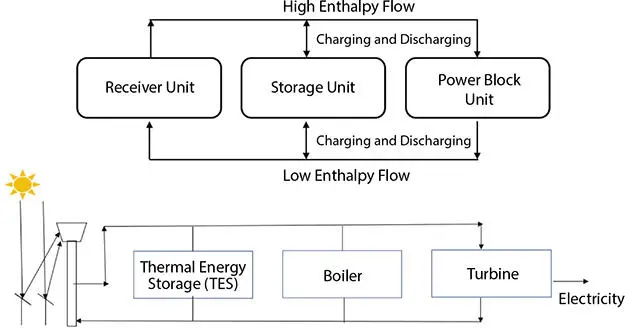
Figure 1.5 Integration of thermal energy storage systems to a CSP plant.
The possibility of integrating the TES system is one of the most distinct advantages of the solar energy field with CSP over other renewable energy fields. There are many storage technologies being developed that can be integrated into CSP plants. To accelerate the development of solar energy power generation in terms of economy and operation, an efficient and cost-effective TES system is important. Many earlier research works have studied the importance of TES on CSP and this results in an energy-efficient power plant (Guo et al ., 2018; John et al ., 2013; Prasad and Muthukumar, 2013; Adinberg, 2011; Powell and Edgar, 2012; Tamme and Laing, 2004; Tian and Zhao, 2013).
Thermal energy storage concepts for CSP plants can be classified as active or passive systems. In an active TES system, the thermal energy storage material itself circulates through a heat exchanger. Active systems can be divided into direct or indirect TES systems. In the commercial CSP plants, only active TES systems are used. Commercial active direct thermal energy storage systems are molten salt systems and steam accumulators. A second medium is used for storing the thermal energy in an active indirect system. A heat exchanger is used to transfer thermal energy from HTF to the second medium.
Two different materials for heat storage and circulation are used for passive storage systems which are dual medium storage systems. The HTF passes through the thermal storage system only for charging and discharging a TES material. The TES material can store energy in terms of sensible or latent heat. Passive TES systems are still under major research and they have not yet reached the commercial CSP plant level. A brief discussion about different TES systems [ Figure 1.6] as incorporated in commercial CSP follows below.
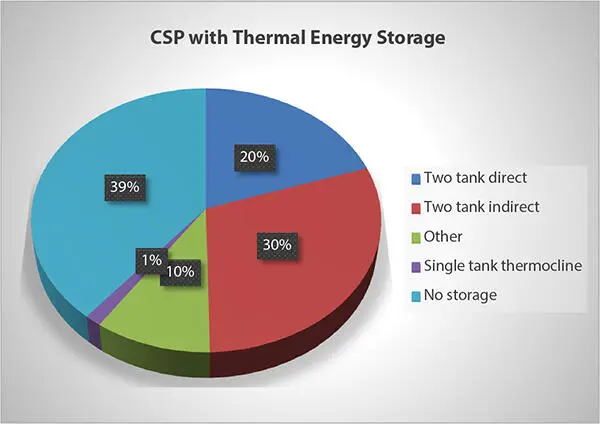
Figure 1.6 Reported integration of thermal energy storage systems in worldwide CSP plants.
1.3.1 Active Two-Tank System
In an Active two-tank system, one tank holds hot HTF and another tank holds cold HTF. The hot HTF and cold HTF do not interact with each other. Major advantages of such systems are there will be no interaction between the fluids. Thus, heat loss is less and temperatures of the fluids in the tanks are almost uniform with time and position. However, two separate tanks of equal volumes are needed for such systems and tanks of the walls are subjected to daily cycles of molten salts. Thermal CSP plants with two-tank-based molten salt system are well documented by Kelly and Kearney (2004) and Herrmann et al . (2004). This concept can be used as direct or indirect storage systems.
1.3.1.1 Active Two-Tank Direct
In an active two-tank direct system, solar radiation is converted to thermal energy and the thermal energy is stored in the same fluid which was used to collect it. The fluid is stored in two tanks, one at high temperature and the other at low temperature. Fluid from the low-temperature tank flows through the receiver and gets heated to a high temperature [ Figure 1.7]. Thereafter the hot fluid flows to the high-temperature tank for storage. Fluid from the high-temperature tank flows through a heat exchanger. In the heat exchanger the fluid loses heat to generates steam which is further used for electricity production. The cold fluid exits the heat exchanger and returns to the low-temperature tank to continue the cycle.
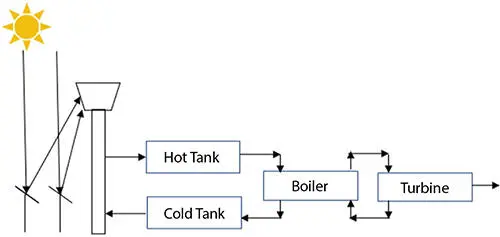
Figure 1.7 Active two-tank direct thermal energy storage.
Concentrating solar power (CSP) projects that use parabolic trough systems such as Archimede, ASE Demo Plant, Chabei, Gansu Akesai, Solar Electric Generating Station I (SEGS I) use active two-tank direct thermal energy system [see Table 1.1]. Dacheng Dunhuang Molten Salt Fresnel project used two-tank direct storage with a storage capacity of 13 hours and Molten Salt as the heat transfer fluid. Such storage systems have attracted a great deal of attention from power tower receiver concept. Power tower projects such as Atacama-1, Aurora Solar Energy Project, Copiapó, Crescent Dunes Solar Energy Project (Tonopah) implement two-tank direct storage system. Currently, 20% of the commercial plants use two-tank direct TES system for energy storage, and the summary of all plants is listed in Tables 1.1, 1.2and 1.3.
Читать дальше
